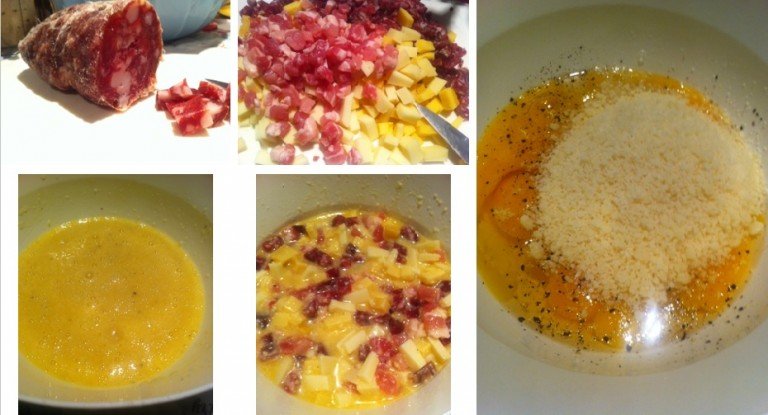 Pasqua (Easter) is approaching and this means different things for different people around the world. On my small, crazy and messy planet Easter is about going back to Naples and spending time with my family, seeing my cousins and nephews and… and… yes, I can read your mind. You know what is coming. For millions of Neapolitans, Easter means pizza chiena, casatiello and pastiera!
Pasqua (Easter) is approaching and this means different things for different people around the world. On my small, crazy and messy planet Easter is about going back to Naples and spending time with my family, seeing my cousins and nephews and… and… yes, I can read your mind. You know what is coming. For millions of Neapolitans, Easter means pizza chiena, casatiello and pastiera!
This Easter trio is responsible for the happiness of so many. I’m not joking when I say that these dishes are “holy” for Neapolitans.
There will be celebrations or tears, depending on how they come out. We wait for months for this moment to come when we will all put on a fair bit of weight as a result of eating slice after slice of pastiere, casatielli and pizze chiene.
And no. We have no regrets. Life’s short. Food is good. Neapolitan Easter food in particular is awesome.

There is a time and place for everything. And Easter is THE time to come together to relax, chat loudly as only Italians can do, and taste traditional dishes made in manic, joyous family kitchens. Of course let’s not forget that these food celebrations are only one part of this Catholic holiday.
If you ever happen to be in Naples during this period, you will see pastiera and casatiello in all pasticcerie, rosticcerie and food shops you walk past. And most importantly, if you are lucky enough to be spending Easter with the family of a Neapolitan friend, on Saturday you will get to treat your tastebuds to the deliciousness of pizza chiena (piena in Italian, meaning full/stuffed): a type of torte filled with cured meats, cheese and eggs. It is made on Good Friday and eaten the next day to seal the end of Lent.
I have no recollection of any Easter Monday spent without having (at the very least) a slice of pizza chiena. It is “chiena” of some of my favourite ingredients: salami, eggs and provolone cheese. And I am very much in love with this dish. It tastes of tradition, of home, of roots, family and happy days.

This Easter will be the first one we are spending without my dad.

It is going to be sad and, to be fair, all the more reason for me to get some comfort from food my dad and my mum made during their life together.

I spoke to my mum the other day and she said she was starting the food prep. I was in shock, but quickly realised it takes a few days to prepare 349,723,897,423,894,790 pizze, pastiere and casatielli.
In fact, in any Neapolitan family many casatielli, pastiere and pizze chiene will need to be made in advance to feed the large number of relatives and friends who will gather around the same table from Friday.

Speaking of which, a story comes to mind that George tells every time whenever we talk to friends about what we usually eat in Naples during Christmas or Easter festivities. Are you ready for this? It goes something like this:
“We were excited to be invited for ‘minestrone’ by the Lubrano and Molino families, and were looking forward to tasting a good, authentic bowl of soup – as well as spending time with our friendly neighbours. When the food came out, we were surprised to see it wasn’t minestrone, but it was really good, so we weren’t going to complain. In fact, we even had seconds, thinking that this was too good not to make the most of, and could afford the space in our tummies, as presumably we only had a bowl of soup to come. But the next course wasn’t minestrone… or the next… and so on. By the time we reached the minestrone we were already stuffed, but very happily so: it had been a feast of delicious food! So much for just a bowl of soup…”
This story sums up what happens in my family, a bit like in any other family to be fair. It is never ever going to be just a simple soup! So be prepared when you receive a similar invitation from a Neapolitan.
I remember that day vividly and we even have a picture from it. We were only 15 then.

But most importantly that also was the last meal we all got to spend together before George’s mummy Liz sadly passed away.

This post is for her, as well as for my dad. This post is for those who are not going to be there with us this Easter.
Anyway, back to this recipe. As always, there are many variations and every family will opt for its own specific selection of cured meats and cheeses. This is the one that’s been used by my grannies for years. Nonna Cristina was the master of Easter pizze and I hope she will be delighted to know that the tradition of pizza chiena carries on through my mother and me.

Although this is a classic Neapolitan Easter dish, there is no reason why you should not make it during the rest of the year: for a buffet menu or a pizza night at yours, for example. Call it torte, call it pizza, but don’t pronounce the forbidden word “pie”.
Ingredients for pizza chiena
Serves 8
For the dough
- 500g flour “00” (or all-purpose flour)
- 250ml warm water
- 4g dried active yeast
- 1 teaspoon of sugar
- 30ml of warm water
- A full teaspoon of salt
- 2 tablespoons of extra-virgin olive oil
For the filling
- 7 medium-sized eggs
- A pinch of salt on each egg
- 70g grated parmesan
- Pepper
- 150g salame Napoli
- 150 unsmoked pancetta
- 250g cheese such as mature gouda (Provolone auricchio, if you manage to find it)
Extra
- 2 tablespoons of extra-virgin olive oil for lining the oven dish and the top of the pizza
Method
Let’s start with making the dough.
Add 30ml of warm water to a large glass, add the yeast and sugar and stir until everything is dissolved. Leave it to rest for 10 minutes, until it gets bubbly.
Meanwhile, get another larger bowl and sift the flour. Create a well and add the previously prepared yeast mixture in the middle, as well as two tablespoons of extra-virgin olive oil.
Start mixing it in the middle with your hands while slowly incorporating some of the flour on the edges. Do so for a couple of minutes until the mixture is smooth.
In a bowl add the rest of the warm water (250ml), the salt and mix well. Pour the water and keep mixing all gradually in the middle until it gets firmer and absorbs all the flour in the bowl.
Add the salt and incorporate it into the mixture. We do that at this stage to make sure the salt does not interact with the yeast, as it would slow down the rising process.
Make the dough into a compact ball shape, before moving it to a surface lightly sprinkled with flour. Let the fun part begin: the kneading!
Press the dough down with your knuckles and spread it. Take the far end of the dough and fold it a short distance toward you. Push it away with the heel of your hand. Repeat this operation for about 10 minutes until you obtain a dough that is smooth and elastic and springs back when you try to flatten it with your fingers.
Get a large bowl, line with a tea towel, sprinkle some flour, place the dough in it covered by a second tea towel. Store it in a dry place for 2 hours, until it has doubled in size.
Meanwhile, preheat the oven to 200˚C (180˚C fan) and start prepare the filling. Grate the parmesan and chop the salami and the cheese into small cubes.
In a bowl break the eggs, add a pinch of salt on each, and add the pepper and the parmesan. Mix well with a fork until you obtain a smooth mixture.
Pour the meats and cheese inside and incorporate everything into the egg mixture.

When the dough is ready, line a 24cm round baking dish with some oil.
Cut the dough in two halves. Move one half to the dish, place it in the middle and with your fingers push it towards the edges of the of the dish, and up the sides to a height of about 2cm. This will help contain the egg mixture.
Gently pour in the egg, meat and cheese mixture and level it with a spoon.
Take the other half of the dough and sprinkle a large piece of baking paper with some flour. With a rolling pin make a disc that is at least 24cm in diameter – enough to cover the surface of the pizza.
This is a tricky step as you need to transfer the dough disk to on top of the pizza base. Gently lift the baking paper with your dough disc on it with two hands. Support the bottom with one hand and incline it gently towards the pizza base, making sure your other hand is there to catch the fall. Once you placed the top dough disk on the egg mixture, you can move and adjust the dough as required. Don’t panic: patience will go a long way 😀
Make sure you seal the top dough to the edge of the bottom one. Strengthen the seal with a fork.
Sprinkle some oil and spread it evenly on the surface.
Place the pizza chiena in the oven for at least 45 minutes, or until it is golden on top and the edges of the pizza are well browned. When ready, take out of the oven and let rest for about 20 minutes before taking out of the baking dish.
Serve warm with a nice salad or at room temperature. You can eat pizza chiena up to two days later. Store in the fridge and warm up in the oven before serving it.
And a very serene Easter to everyone. ❤
E buona pizza chiena a tutti 😀




What a beautiful post – brought me to tears. Happy Easter super chef – thinking of you xxxx
Questa supera quasi il Casatiello!mamma le uova dentro non le mette,proverò a fargliela fare come la fai tu!ho già L acquolina!!!